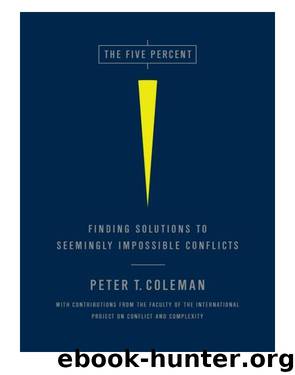The Five Percent by Peter Coleman

Author:Peter Coleman
Language: eng
Format: epub
Publisher: PublicAffairs
Published: 2011-03-21T16:00:00+00:00
CONFLICT-MAPPING 2: SIMPLIFY THINGS
Help!!!
In early 2010, NBC reporter Richard Engel uncovered a wildly complicated PowerPoint map depicting U.S. strategy to increase popular support for the Afghan government. It involved over 100 elements, each with multiple links or loops to other nodes. It was characteristic of the U.S. military’s current approach to counterinsurgency and what some officers refer to as a “fur ball.” Upon first seeing the map, General Stanley A. McChrystal, leader of American and NATO forces in Afghanistan at the time, remarked, “When we understand that slide, we’ll have won the war.”15
At the heart of much of what we’ve discussed so far is the double-edged sword of complexity. If the story of a conflict has lost complexity and become overly simplistic and polarized, we must reintroduce nuance into our understanding of the situation. But adding too much complexity can easily make an already complicated situation overwhelming, even immobilizing. Or it can lead to increased resistance and an even stronger push to oversimplify and choose sides.
It’s vital to employ a few general tactics for managing complexity. This will permit us to see both the forest and the (more important) trees in the 5 percent. Each tactic is informed by our model and in particular by the approach of dynamical minimalism, whose goal is to make use of the complexity of a problem in order to find the minimal set of mechanisms that can account for its evolving pattern, its character. Once again, the goal of dynamical minimalism is simplicity informed by complexity.16
In this section we outline five actions for harnessing the complexity generated in phase 1 of conflict-mapping; they will help us to develop more focused strategies and insights for understanding and leveraging change in 5 percent conflicts. They are (1) identify hubs, loops, and energy in the system, (2) identify local actionables, (3) locate what is already working, (4) identify integrative agents, and (5) visualize the attractor landscape.
Download
This site does not store any files on its server. We only index and link to content provided by other sites. Please contact the content providers to delete copyright contents if any and email us, we'll remove relevant links or contents immediately.
| Arms Control | Diplomacy |
| Security | Trades & Tariffs |
| Treaties | African |
| Asian | Australian & Oceanian |
| Canadian | Caribbean & Latin American |
| European | Middle Eastern |
| Russian & Former Soviet Union |
The Secret History by Donna Tartt(18852)
The Social Justice Warrior Handbook by Lisa De Pasquale(12143)
Thirteen Reasons Why by Jay Asher(8800)
This Is How You Lose Her by Junot Diaz(6796)
Weapons of Math Destruction by Cathy O'Neil(6148)
Zero to One by Peter Thiel(5690)
Beartown by Fredrik Backman(5600)
The Myth of the Strong Leader by Archie Brown(5427)
The Fire Next Time by James Baldwin(5250)
How Democracies Die by Steven Levitsky & Daniel Ziblatt(5129)
Promise Me, Dad by Joe Biden(5088)
Stone's Rules by Roger Stone(5027)
A Higher Loyalty: Truth, Lies, and Leadership by James Comey(4846)
100 Deadly Skills by Clint Emerson(4842)
Rise and Kill First by Ronen Bergman(4705)
Secrecy World by Jake Bernstein(4651)
The David Icke Guide to the Global Conspiracy (and how to end it) by David Icke(4628)
The Farm by Tom Rob Smith(4439)
The Doomsday Machine by Daniel Ellsberg(4419)
